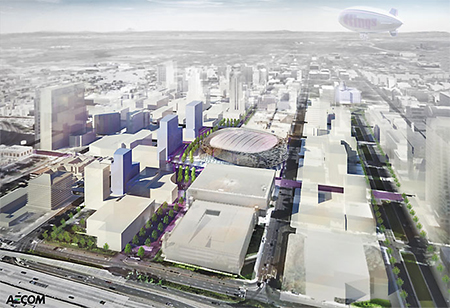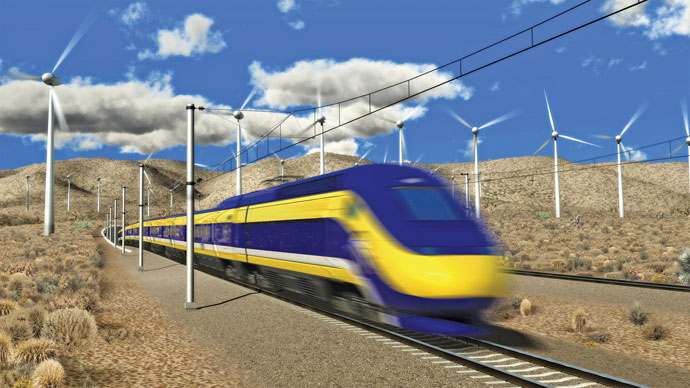
Burney Falls in Shasta County is one of California’s many natural attractions.
Could the decade of the 2010’s turn out to be the new Golden Era for the Golden State? It may not be as far-fetched as it sounds.
Thanks to a slew of large-scale corporate facility projects, California is poised to continue one of its busiest real estate expansion periods in state history. From LinkedIn’s new 3,000-employee campus in Sunnyvale to Amazon’s gigantic fulfillment centers in Patterson and Tracy, a lot of gold – i.e., money – is being poured into the ground in the form of business expansions around the state.
The roll call of mega-projects seemingly has no end: Ross Dress for Less is creating a new 1.7-million-sq.-ft. complex in Shafter; Trinchero Family Estates is expanding its wine operation in Lodi by 400 jobs and 700,000 sq. ft.; and Dollar General is adding 606,000 sq. ft. in Tejon Ranch. What’s happening?
From Sacramento to San Diego, business is booming. In fact, it’s booming so much that California’s total revenues for June came to $13.1 billion, besting Gov. Jerry Brown’s May budget revision estimate by $1.2 billion or 10.1 percent. Total state government revenues for the fiscal year ending June 30 were $100.1 billion, topping estimates by $2.0 billion.
For the first time in a long time, optimism can actually be heard in the voices of corporate real estate executives in California.
“Getting the smartest and most creative minds to come work for us is the number one reason why Juniper is located right here in Silicon Valley. Plus, our geographic location is fantastic. It is a wonderful climate, and there are world-class universities near us that we can draw from.“
— John Lucas, vice president of global real estate and workplace services, Juniper Networks
“We have been expanding for some time,” says Tom Eickhoff, director of global real estate for KLA-Tencor, a $9.37-billion semiconductor manufacturing company based in the San Jose MSA in the heart of Silicon Valley. “We had a shell building of 30,000 square feet, and we added a clean room and completely redid all of our office space in the town of Milpitas.”
Eickhoff says KLA-Tencor has also “put together a master plan for our headquarters of the future – a 730,000-square-foot corporate campus. We will remain in California because Silicon Valley is almost its own world. The skill base here is unmatched. Our best access to talent is right here, and most of our engineering actually occurs here at our corporate headquarters.”
Eickhoff is not alone. At Juniper Networks in nearby Sunnyvale, John Lucas is presiding over an expansion project of his own.
“We just embarked on a pretty significant investment – the first phase of our corporate headquarters campus,” says Lucas, senior director of real estate and workplace services for Juniper, a $10.36-billion manufacturer of Internet networking equipment. “We own 80 acres in Silicon Valley and two years ago, we started developing a corporate campus on that land. We have the ability to put up about 10 buildings totaling 2.4 million square feet of office and R&D space on this property. We just started the first phase – two 8-story buildings totaling 635,000 square feet of space.”
A “huge talent pool in the immediate area” justifies Juniper’s presence in Sunnyvale, says Lucas. “Getting the smartest and most creative minds to come work for us is the number one reason why Juniper is located right here in Silicon Valley. Plus, our geographic location is fantastic. It is a wonderful climate, and there are world-class universities near us that we can draw from.”
Gov. Brown’s Aggressive Agenda
KLA Tencor and Juniper are joining a rapidly growing cadre of companies betting big on California as a long-term business destination.
A quickly improving business climate – despite the many naysayers around the country – is making it easier for these firms to expand right where they are.
Since being elected to his third term as governor in 2010 – following two terms from 1975 to 1983 – Gov. Brown has enacted a series of reforms aimed at improving the climate for business in California. After taking over a state facing the worst budget crisis in the nation, Brown recently signed his third consecutive balanced budget and has reduced the state cash deficit from $9.6 billion to $2.4 billion.
“Rising employment, economic expansion and voter-approved tax increases have generated revenues outperforming even the rosiest of projections,” state controller John Chiang said in mid-July. “However, California’s history of boom or bust revenue cycles should be a cautionary tale that informs our spending decisions and incentivizes policymakers to prudently pay down accumulated debt.”
So far, in his second act as governor, the 75-year-old Brown has played the role of budget deficit hawk more than he has the role of free-spending liberal. As a result, the ratings service Standard & Poor’s raised California’s credit rating from A- to A for the long-term rating on much of California’s bond debt. S&P also raised from BBB+ to A- the state’s long-term rating on $9.3 billion in lease revenue bonds issued for projects in the University of California system.
S&P noted that the “upgrades reflect our view of California’s improved fiscal condition and cash position, and the state’s projections of a structurally balanced budget through at least the next several years.”
Moody’s Investors Service, meanwhile, upgraded from Aa3 to Aa2 its rating on $5.2 billion of outstanding California Economic Recovery Bonds, citing two years of strong growth in the revenue used to pay the debt.
On top of those upgrades, Fitch changed California’s outlook to “positive” following Gov. Brown’s proposal, earlier this year, which projected California would end the year with a surplus for the first time in nearly a decade.
The upgrades come even as Brown overhauls the state’s entire approach to economic development. The Legislature this year passed the governor’s measures to reform what has become an ineffective Enterprise Zone program and replace it with a more flexible set of tools. The new law redirects money in economic development funds toward three new incentive programs. These include spending $400 million on a sales tax credit to boost manufacturing and biotech R&D; $200 million on updated enterprise zones that provide incentives for hiring the poor and jobless; and up to $100 million to reward specific businesses that choose to relocate to California from other states.

Mount Shasta in Northern California draws visitors from all over the world.
Brown also signed into law significant workers’ compensation reforms, pension reforms that save billions of taxpayer dollars, and regulatory reform. SB 1099 requires new regulations to be announced on the same day each quarter.
John Kabateck, executive director off the National Federation of Independent Business for California, said, “The NFIB and small business owners throughout California are grateful to Gov. Brown and the members of the Legislature for recognizing the importance of this bill.”
Brown also plans to shrink the size of California’s bloated bureaucracy. Delivering on his promise to streamline state government, Brown enacted a sweeping reorganization plan that reduces the number of state agencies from 12 to 10 and eliminates duplicative and unnecessary entities. The changes include bringing key economic development functions under the Governor’s Office of Business and Economic Development (GO-Biz).
The governor also signed into law an act to help businesses get started and hire workers more quickly in California. AB 113 directs additional funds to the Secretary of State’s Office to accelerate the state’s business filing process and eliminate what has become a huge backlog of filings.
The goal of the measure is to reduce the average waiting period for business filings to be processed from 90 days to an average of five to 10 days by this November.
Jobless Rate Declines Sharply
The results of Brown’s reforms have been quite substantial. Since the governor took office in 2011, California has created 574,000 jobs, the second highest amount in the nation, even while the state shed public-sector jobs. During this time, California’s unemployment rate fell from a national high of 12.1 percent to 8.6 percent, which is just above the national average.
As a result, California is now the No. 1 state for manufacturing both in jobs and output. Manufacturers in California account for 11.7 percent of the total state GDP and employ nearly 9 percent of the state’s work force. Total output from manufacturing was $230 billion in 2011, far more than any other state.
California’s newfound economic strength is reflected in other recent rankings:
- California received almost 50 percent of all venture capital financing in the U.S. in 2011, by far the most in the U.S., according to Ernst & Young.
- California ranks as the No. 1 state for attracting foreign direct investment, according to the Congressional Research Service.
- Four of the top 20 regions in the U.S. for job growth are in California: Los Angeles-Long Beach-Santa Ana; San Francisco-Oakland-Fremont; San Diego-Carlsbad-San Marcos; and Riverside-San Bernardino-Ontario.
- California’s GDP growth in 2012 was the fifth-best in the nation, according to the U.S. Bureau of Economic Analysis.
- California leads Fortune magazine’s 2012 list with 24 of the 100 fastest growing companies, more than double the next closest state, Texas.
- California remains the top state for high-tech employment in the 2013 edition of Tech America’s report, Cyberstates.
- California ranks No. 1 in agricultural revenues, with $34.8 billion in revenue representing 12.3 percent of the total farm crop sales in the U.S., according to the California Department of Food and Agriculture.
- California exports reached an all-time high of $161.7 billion in 2012, according to the International Trade Administration of the U.S. Department of Commerce.
- Two-way trade through the Los Angeles Customs District rose by 4.3 percent last year to a record $403.4 billion. The district serves the two largest container ports in the country – the San Pedro Bay ports of Los Angeles and Long Beach.
All these numbers portend a new wave of business growth in the Golden State. And nowhere is that growth occurring any more robustly than in the high-tech sector.
Tech Sector Growing Swiftly
According to a report just published by Jones Lang LaSalle, California boasts the top three high-tech markets in the country. San Francisco leads the U.S., followed by Silicon Valley and the San Francisco Peninsula, according to JLL.
“Silicon Valley did a lot to pump money into this state. When Facebook went public, a lot of money went to the state of California. It definitely has an impact. There is now positive speculation for the future of the Valley. About 6 million square feet of new space is being built here, and we are certainly contributing to that.“
— Tom Eickhoff, director of global real estate for KLA-Tencor
The JLL index rates each city on four primary factors: high-tech employment; share of U.S. venture capital funding; intellectual capital; and innovation.
“High-tech industry growth has outpaced the national economy by an average of four to one since 2010,” said Amber Schiada, research manager for JLL. “This economic contribution is driven by startups, many located in high-tech incubators offering office space, but also access to professional services, collaboration, and venture capital opportunities.”
The expansions at KLA Tencor and Juniper Networks reflect this trend, say the executives who are managing the real estate portfolios at these high-tech firms in Silicon Valley.
“Silicon Valley did a lot to pump money into this state,” says Eickhoff of KLA Tencor. “When Facebook went public, a lot of money went to the state of California. It definitely has an impact. There is now positive speculation for the future of the Valley. About 6 million square feet of new space is being built here, and we are certainly contributing to that.”
Juniper’s Lucas says that it made the most sense for his company to expand right where it’s already located. “We ran a lot of financial models and looked at the overall cost to the company,” he says. “We looked at all types of real estate options – leasing, sale-leaseback, purchasing property in the area. At the end of the day, building on our own property proved to be the most financially beneficial to us.”
Many Silicon Valley-based companies are following suit. One of the biggest to do so is LinkedIn, the social networking company for professionals. The Mountain View-based firm announced last year that it will expand to a new office campus of 580,000 sq. ft. in Sunnyvale.
The $29.61-billion company plans to move into its new home next July as part of a lease agreement that extends into 2026. The campus could accommodate nearly 3,000 workers.
A spokesperson for LinkedIn said that the firm would retain its existing headquarters in Mountain View, which is also undergoing an expansion of 70,000 sq. ft.
Other huge projects announced this year in California include Forever 21’s 1.8-million-sq.-ft. deal in Los Angeles; Icon Health and Fitness’s 600,000-sq.-ft. facility in Beaumont; and Paramount Citrus’ 600,000-sq.-ft. project in Delano.
Market Snapshots Paint Picture of a Rebound
Corporate real estate executives aren’t the only ones buoyed by a new spirit of optimism about California’s economy these days. Economic developers, after enduring years of budget cuts and runaway deficits at the state capital, tell Site Selection that business is rebounding sharply across the Golden State.

Rendering shows the Sacramento Kings’ planned new arena.
What follows is their story, told here in their words:
Tim Kelly, president of Team California and president and CEO of the Imperial Valley Economic Development Corp. in El Centro near the Mexico border: “Projects we had been working on for years are now coming to fruition. We went from having almost no solar energy to now leading North America in solar energy projects. We have 2.5 gigawatts under development and over 1 gigawatt in construction right now. We lead North America in geothermal energy and we are up to 600 megawatts of electricity generated through thermal energy. Our potential is 2,500 to 3,500 megawatts of thermal power. Another three to five projects are permitted and will begin construction soon.”
“Rising employment, economic expansion and voter-approved tax increases have generated revenues outperforming even the rosiest of projections.“
— State Controller John Chiang
Barbara Hayes, president and CEO of the Sacramento Area Commerce & Trade Organization (SACTO): “In the spring of 2011, the Sacramento region started to see signs of recovering in terms of job growth. We have had consecutive monthly job growth since April of 2011. We are now in the single digits in unemployment. In the last year, we have seen a tremendous amount of investment in the region from outside investors. A group of investors stepped up to purchase the Sacramento Kings of the NBA, and now we are getting a brand new arena for them. We have also seen largest corporate facility projects from Sutter Health Care System and Advanced Call Center Technologies.”
Greg Hribar, manager of economic development for the Sacramento Municipal Utility District: “We have some pretty significant names – Intel, Siemens and GenCorp – which are all growing right here in our service area. PennyMac and Penske Logistics are also expanding here. We are seeing signs of significant improvement, and we are excited about the future of the Sacramento region.”
Randy Starbuck, director of economic development for the City of Elk Grove: “The Apple facility here is running at capacity. The iPhone 4 and 5 are being refurbished here. They have 1,200 to 1,400 people working at that plant. The iMac was born here in Elk Grove inside that facility. Apple is very quiet about what they do there, but they are always busy and they seemingly are always growing. We’ve also seen expansions at Sytech, NutriShare, GNB Valves, Isola Group and others.”
Mark Lascelles, president of the Shasta Economic Development Corp.: “Probably one of the biggest trends we are seeing is that a Christian-based leadership program is bringing 1,500 to 2,000 students a year into the community at the post-graduate level. When they graduate, a lot of them look to stay and that builds a very well qualified labor pool. The Bethel Church is attracting these young people, and it has global connectivity. This is building a labor pool like we have never seen before. We have been able to attract a lot of back-office operations and startups from Silicon Valley and all over the state. We have seen expansions from Southern Aluminum Finishing, TechnoSoil, Axcient, Tegile Systems, and a drone helicopter R&D operation for the Hill Group.”
Mike Amman, president and CEO of the San Joaquin Partnership: “Everyone knows about Amazon’s new facilities in Patterson and Tracy, but they don’t know that ProLogis bought 1,200 acres in Tracy. This is their flagship location in Northern California. The Port of Stockton has its second best year ever in the past 80 in overall revenue. They opened up the Marine Highway for getting goods out of the Port of Oakland. DTE Energy is doing a $100-million biomass plant that is in the final stages of construction here. Gavilon will process palm oil from Malaysia and that project is in the final stages in the port.”
Rob Moran, economic development manager for Riverside County: “Active sectors now are logistics and manufacturing. ALDI Foods selected Moreno Valley for their Western U.S. headquarters location. That will be well over 200 jobs and it represents a large capital investment into a 935,000-square-foot facility. Also, ICON Health and Fitness is building a new facility in Beaumont. Our jobless rate is 9.2 percent. It was 15 percent at the peak of the recession.”
Bullet Train Could
Reshape California Economy
California’s planned $70-billion high-speed rail system promises to dramatically overhaul the state’s heavily congested transportation system.
If it’s built, the northern and southern portions of the state will be connected like never before, says Tom Richards, vice chair of the California High-Speed Rail Authority Board of Directors.
In an exclusive interview with Site Selection, Richards addressed the remaining hurdles in the way of the project – approved and signed into law last July by Gov. Jerry Brown – and the expected economic impact of the bullet train if it remains on track to completion by 2029.

The planned $8-billion California High-Speed Rail project would run from San Francisco to Los Angeles in just under three hours. The system would eventually extend to Sacramento and San Diego, total 800 miles, and have up to 24 rail stations.
Photo illustration courtesy of the California High-Speed Rail Authority
Site Selection: Do you see any reason why the high-speed rail project will not be completed in California?
Tom Richards: I can’t foresee any reason at all why it won’t be built. Whatever issues remain before us are issues that may have some minimal impact on timing but not on the viability of the project moving forward. There have been legal challenges, and we have worked very diligently on all of them. We have an appeal on one bit of litigation that ruled in our favor. Right now, we are waiting on a judge’s opinion on another matter. The judge’s opinion will weigh heavily on our start date. We won’t issue a notice to start the project until we receive the judge’s ruling. Assuming the ruling is in our favor – and we feel confidently that it will be – we could enter into a contract on construction package number one within two to three weeks and construction would then begin on the first 29-mile segment of the system
SS: What will the first phase of the project look like?
Richards: This first construction package is from just east of downtown Madera and will extend southeast to a stop just south of downtown Fresno. Sporadic construction activity will go on through 2013. We have used the private-sector approach to do a design-build contract. Our goal is to transfer as much of the exposure and liability as possible to the private sector, which will build the project. We provide 15 percent of the design-build drawings. They complete it and submit it to our board for approval. About 200 engineers are being brought into the market here and they will be up and in operation within 60 days. By the end of
“This system will serve over 80 percent of the population in California. I think it’s going to start a revolution for surface transportation in the country. This really puts teeth in the idea of transportation-oriented development and intermodal networks.“
— Tom Richards
2017, roughly 130 miles will be completed – the Madera to Bakersfield line. All funds for future construction must be committed for the project by the end of September 2017. By 2022, a 300-mile-long leg should have revenue traffic.
SS: What will be the economic impact of this project?
Richards: It will be a lot. It is the first real step in improving surface transportation in California in over half a century. It dates back to the 1970s when Jerry Brown was governor during his first two terms. He was discussing a bullet train back then. If you go back to the late 1950s and early 1960s, his father Pat Brown was governor and it was envisioned for the first time then. We have been trying to help it evolve and serve a hugely larger population today. We will add a population the size of New York to California by the year 2050, and we are struggling to handle the surface transportation of all these people. In California, we have got the busiest short-haul air traffic market in the country – over 5 million passengers a year between Los Angeles and San Francisco. Over a quarter of the flights are delayed by over an hour already. We have six of the 30 most congested traffic markets in the U.S. Loss in economic activity in 2011 from traffic congestion cost California in excess of $19 billion.
SS: What problems will this project solve?
Richards: The high-speed rail will not solve all of our problems, but it will provide a safe, convenient and friendly transportation connection between Southern and Northern California, and do it in the fastest growing area of the state – the Central Valley. Eventually, it will go from San Jose to the Central Valley too, and it will take people from Los Angeles to Anaheim and San Diego. It is an opportunity to expand the economic footprint of California. We have had some of the highest unemployment rates in the country in the Central Valley. This will bring much-needed jobs to that region.
SS: What impact will the high-speed rail have on commuting times and patterns?
Richards: We have done very detailed ridership studies. For those who have to commute regularly between Northern and Southern California, it is a means to get there more conveniently – equal to airline speeds – without the hassle of going through airline terminals. There is nothing else on the horizon comparable to that. A one-seat ride from San Francisco to Los Angeles in 2 hours and 40 minutes is the mandate passed by the voters in Proposition 1A in 2008. We will not replace or displace the existing Amtrak services in California. We have three of the five most traveled passenger corridors in the country. We are part of the rail passenger solution. I have yet to find anyone in California who believes that our freeway systems are adequate.
SS: How many Californians will benefit from this?
Richards: This system will serve over 80 percent of the population in California. I think it’s going to start a revolution for surface transportation in the country. This really puts teeth in the idea of transportation-oriented development and intermodal networks.
– by Ron Starner
